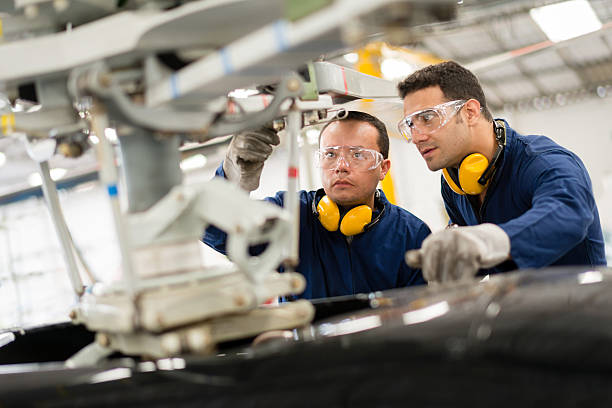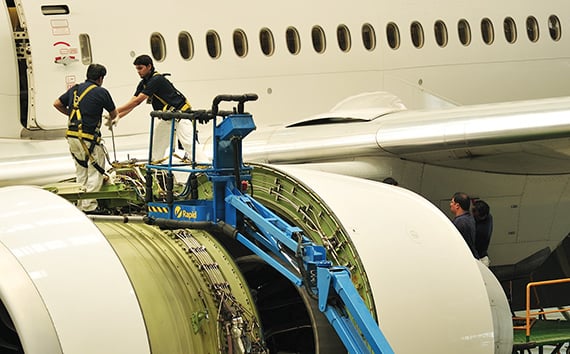
Aircraft Engineer Job Description and Roles/Responsibilities, Qualifications
Aircraft engineer job description: In this article, we discuss the Aircraft engineers’ job description, roles/responsibilities, and qualifications.
They primarily develop aircraft and propulsion systems and investigate the aerodynamic performance of aircraft and building materials. They work with the theory, technology, and practice of flying within the atmosphere of the Earth.Information Guide Nigeria
👉 Relocate to Canada Today!
Live, Study and Work in Canada. No Payment is Required! Hurry Now click here to Apply >> Immigrate to CanadaWho are Aircraft Engineers
Aircraft engineers are experts in all elements of aircraft science and technology. They research, design, and develop components and devices used in the operation of aerial vehicles. They display models using computer-aided design solutions, integrating technical expertise with software skills.
As an aircraft engineer, you will assemble, test, and modify engines and other support equipment for numerous types of airplanes. Your duties will involve maintenance activities and examining and servicing damaged aircraft.
You will test this equipment to assess its performance and improve its safety features. These specialists are currently focused on environmental impact. Therefore, you will spend significant time researching environmentally efficient ways to fuel and operate airplanes.15 Best Smart Watches in Nigeria and their Prices
Read Also: Actuary Job Description, Roles/Responsibilities, and Qualifications
Responsibilities of an Aircraft engineer
- In charge of overseeing the construction of planes’ internal components and power plants
- Conducting flight tests to evaluate aircraft performance and pinpoint areas for enhancement
- Planning the layout of an aircraft’s systems
- Using scientific methods to boost aircraft efficiency.
- Studying and reducing aircraft’s adverse effects on the environment.
- Examining the root causes of aircraft malfunctions or crashes
- Making client reports and offering expert guidance
- Keeping planes in good shape and inspecting them frequently
- Led the software development for many successful NASA and DOD small business innovative research (SBIR) programs.10 Best Half Shoes and their Prices in Nigeria
- Using a project-based matrix permission technique, manage Jenkins security by granting particular access to authorized developers/testers.
- Using AutoCAD, create private jet galleys.
In MATLAB, create a flight data extraction and visualization software package. - Extreme precision is required for calibrating, adjusting, testing, and maintaining equipment components, devices, and systems.
- Using CATIA V4, V5, and CADEX programs, complete equipment installations, wiring diagrams, and test fixtures.
- Support the implementation and development of new NDT technologies.
- Establish NDT system design criteria to meet manufacturing capacity and capability needs.
- Perform several augments, including installing and adding additional devices/servers, adding Unix setups for video streaming, and reviewing router configurations.
- Examine the technical documentation for all CNI systems, including IFF systems, on HMX-1 helicopters.

Roles of an aircraft engineer
An aircraft engineer’s role involves applying scientific and technological principles to the research, development, and design aircraft and their components.
Aircraft engineers research design specifications for aircraft and the appropriate support equipment. The role sometimes involves assembling, testing, and modifying these components.
There are also aircraft maintenance jobs under the umbrella of aeronautical engineering jobs. These roles involve making inspections, overseeing maintenance, and servicing aircraft. This work is generally carried out in offices, factory production hangars, or aeronautical laboratories.
👉 Relocate to Canada Today!
Live, Study and Work in Canada. No Payment is Required! Hurry Now click here to Apply >> Immigrate to CanadaAircraft engineering also involves performance testing. Engineers aim to improve safety features and minimize fuel consumption and pollution. In fact, aeronautical engineering has an increasing focus on the environmental impact of aircraft.
Engineers may need to use aircraft computer-aided design (CAD) software such as DOORs and NASTRAN, so there is often a call for software specialists and IT skills.
Read Also: Marine Infantry Job Description, Roles/Responsibilities, and Qualifications
Aircraft engineer job qualifications/skills
- Applicants must possess a 10+2 PCM diploma or an equivalent AICTE-approved three-year engineering diploma in any field.
- Applicants cannot have colorblindness or any other physical impairments.
- Applicants must have a 10+2 PCM score of at least 45 percent or equivalent.
- The technical nature of the work requires a technical mind and the capacity to comprehend complex systems.
- Design and problem-solving skills that are innovative, as this work frequently involves cutting-edge technology
- The capacity to decipher and analyze complex material and apply your discoveries.
- A drive to stay current with industry technological advancements.
- You will be collaborating with a variety of people. Therefore, teamwork skills are crucial. You will need to collaborate with clients, managers, and suppliers daily.
- Project management abilities will be helpful when supervising aircraft assembly and their systems.
- Your excellent communication abilities will benefit clients and suppliers in the industry’s technical and regulatory guidance.Npower Recruitment
Aircraft engineer Salary structure in the USA
The average annual salary for an aircraft engineer in the United States is $72,867 ($35.03/hour). The annual salary range for aircraft engineers is between $53,000 and $99,000, with the least 10% making around $53,000 and the highest 10% making $99,000.
Read Also: Heb Job Description, Roles/Responsibilities, and Qualifications
Types of the Aircraft engineer
Aeronautical and aerospace engineers
Most aircraft engineers work in the fields of aeronautics and aerospace engineering.
Engineers often work on plans, designs, and blueprints in aeronautics for building aircraft and parts like jet propulsion systems, mechanical parts, navigation instruments, and communication systems.
Aerospace engineers also work on airplanes but spend most of their time making spaceships and the systems and parts needed for space travel.
These engineers can specialize in areas like electrical, mechanical, software, and manufacturing engineering within aeronautics and aerospace.JAMB Form
Electronics and systems engineers
Electronics and systems engineering is usually the area of expertise for engineers who design and build aircraft instrumentation and communication systems.
These experts design and put together the electronics and instruments that pilots use to control planes. This includes system gauges, communications technology, radar systems, navigation systems, and electrical controls for different parts of propeller planes, helicopters, and jets.
Systems engineers may also use robotics and artificial intelligence to create control systems and programs to help pilots fly planes.WAEC Result
Read Also: Hobby Lobby Job Description, Roles/Responsibilities, and Qualifications
Software and computer engineers
Engineers who work on planes can also be good at making software and programming computers.
Software and computer engineers who work in aeronautics often create, test, and integrate the software and system programs that many modern aircraft need to run.
They also work with other engineers to finish design projects from start to finish.
Software engineers and computer programmers are essential in designing and developing electronic systems, navigation, and computerized operations that spacecraft use while in flight.
Mechanical and structural engineers
When it comes to building planes, mechanical engineers who work in aeronautics are mechanics and structural design experts.
They help design and improve an aircraft’s frameworks, engine parts, landing gear, and hydraulic parts.
Mechanical engineers are also often in charge of testing an airplane’s ability to fly. During these tests, they look at the plane’s aerodynamics, operational efficiency, and structural integrity.
Many aircraft engineers also fix and maintain aircraft to keep them safe and working.
Manufacturing and industrial engineers
Engineers in manufacturing or industry may also focus on aircraft or aeronautical engineering.
Manufacturing engineers are responsible for companies’ processes to make aircraft parts and components. They also develop ways to improve the manufacturing process as a whole.
Industrial engineers in the aviation industry may also be in charge of and develop ways to improve how airplanes are made by integrating people, factory procedures, and logistics to help establish company products.
Read Also: Physician Assistant Job Description and Roles/Responsibilities, Qualifications
Conclusion
Management jobs may provide Aircraft engineers with the opportunity for professional progress. One possible career path for engineers is to advance to project management and lead a team of engineers. They could reach out to the director of engineering or another high-ranking management post. Some professionals in the aviation industry choose to launch their engineering consulting firms.JAMB Result
Check JAMB Result
Check and Confirm: How much is Dollar to Naira








